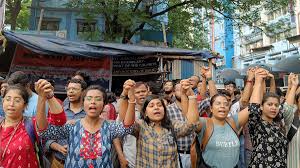
In recent years, West bengal has experienced a significant rise in safety concerns, especially regarding the safety of women. The situation, which was once considered a beacon of cultural pride, now casts a shadow of fear and helplessness. Here’s a breakdown of the factors contributing to the state of women’s safety in Bengal:

1. A State in Crisis: A Cultural Decline
Once a hub of culture and progress, bengal is now plagued by rising incidents of violence against women. Where Tagore’s ideals once thrived, a new atmosphere of fear and lawlessness has replaced the hope for women’s safety. The situation has worsened under the current political climate.
2. TMC’s Neglect: A Leadership Failure
The ruling Trinamool Congress (TMC) under mamata banerjee has faced significant criticism for failing to ensure the safety of women. Despite high-profile promises of a safer bengal, the rising cases of crimes such as rape, molestation, and domestic violence suggest a profound disconnect between political promises and ground realities. The police often appear to be ineffective, and public spaces have become increasingly unsafe for women.
3. The Dark Side of Politics: A culture of Impunity
One of the most alarming aspects of Bengal’s safety crisis is the apparent political patronage of criminals. Many reports indicate that local TMC leaders, instead of upholding justice, provide protection to perpetrators, creating an environment where women’s voices are drowned out. Victims face immense hurdles in seeking justice, with political influence making accountability almost impossible.
4. The Rising Wave of Violent Crimes
Bengal has witnessed a rise in violent crimes against women, especially in areas where law enforcement is weak. From the horrific rape and murder cases to daily instances of harassment, women are left vulnerable. The lack of swift justice and political indifference to women’s safety has compounded the fear women live in every day.
5. Fear and Silence: Women’s Struggle to Be Heard
One of the most tragic elements of this situation is the culture of silence that surrounds it. Fear of backlash from powerful political figures has prevented many women from speaking out. The growing hopelessness within the victimized community is undeniable, and it only reinforces the notion that women’s lives are less valuable in the eyes of the authorities.
6. Calls for Accountability: Time for Action
There has been growing public outcry demanding greater accountability from the state government. Advocacy groups, media outlets, and concerned citizens have raised voices for better policing, stronger laws, and greater political accountability. The question remains: Will the government heed the call for reform?
7. A Long Road Ahead: The Need for Change
The road to restoring bengal as a safe place for women is long and fraught with challenges. It will require not only changes in law enforcement and policy but also a deep cultural shift toward respecting women’s rights and dignity. Until then, Bengal’s streets will remain a battleground for women, overshadowed by fear and uncertainty.
Disclaimer:
The views and opinions expressed in this article are those of the author and do not necessarily reflect the official policy or position of any agency, organization, employer, or company. All information provided is for general informational purposes only. While every effort has been made to ensure accuracy, we make no representations or warranties of any kind, express or implied, about the completeness, reliability, or suitability of the information contained herein. Readers are advised to verify facts and seek professional advice where necessary. Any reliance placed on such information is strictly at the reader’s own risk.




 click and follow Indiaherald WhatsApp channel
click and follow Indiaherald WhatsApp channel